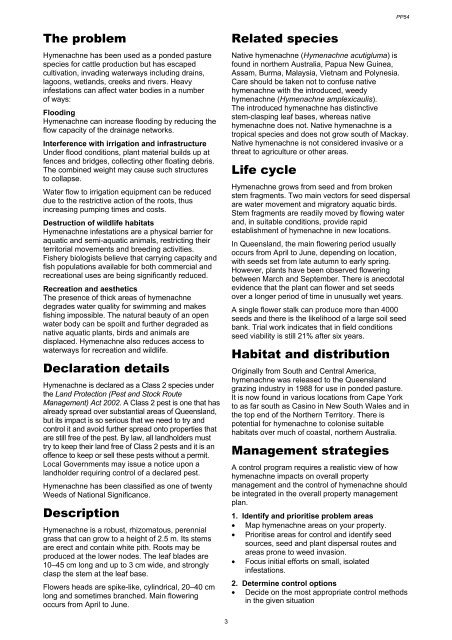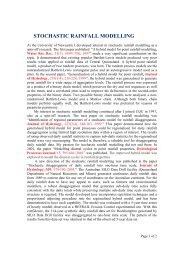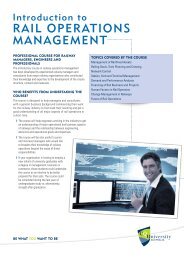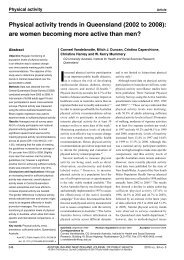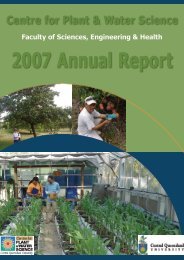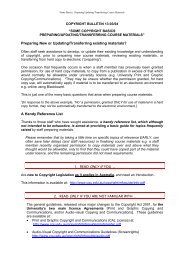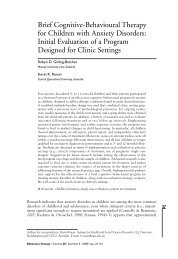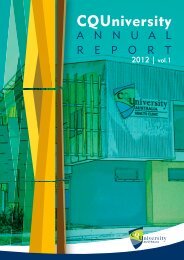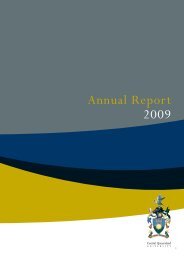Hymenachne - PP54 - Central Queensland University
Hymenachne - PP54 - Central Queensland University
Hymenachne - PP54 - Central Queensland University
Create successful ePaper yourself
Turn your PDF publications into a flip-book with our unique Google optimized e-Paper software.
<strong>PP54</strong>The problem<strong>Hymenachne</strong> has been used as a ponded pasturespecies for cattle production but has escapedcultivation, invading waterways including drains,lagoons, wetlands, creeks and rivers. Heavyinfestations can affect water bodies in a numberof ways:Flooding<strong>Hymenachne</strong> can increase flooding by reducing theflow capacity of the drainage networks.Interference with irrigation and infrastructureUnder flood conditions, plant material builds up atfences and bridges, collecting other floating debris.The combined weight may cause such structuresto collapse.Water flow to irrigation equipment can be reduceddue to the restrictive action of the roots, thusincreasing pumping times and costs.Destruction of wildlife habitats<strong>Hymenachne</strong> infestations are a physical barrier foraquatic and semi-aquatic animals, restricting theirterritorial movements and breeding activities.Fishery biologists believe that carrying capacity andfish populations available for both commercial andrecreational uses are being significantly reduced.Recreation and aestheticsThe presence of thick areas of hymenachnedegrades water quality for swimming and makesfishing impossible. The natural beauty of an openwater body can be spoilt and further degraded asnative aquatic plants, birds and animals aredisplaced. <strong>Hymenachne</strong> also reduces access towaterways for recreation and wildlife.Declaration details<strong>Hymenachne</strong> is declared as a Class 2 species underthe Land Protection (Pest and Stock RouteManagement) Act 2002. A Class 2 pest is one that hasalready spread over substantial areas of <strong>Queensland</strong>,but its impact is so serious that we need to try andcontrol it and avoid further spread onto properties thatare still free of the pest. By law, all landholders musttry to keep their land free of Class 2 pests and it is anoffence to keep or sell these pests without a permit.Local Governments may issue a notice upon alandholder requiring control of a declared pest.<strong>Hymenachne</strong> has been classified as one of twentyWeeds of National Significance.Description<strong>Hymenachne</strong> is a robust, rhizomatous, perennialgrass that can grow to a height of 2.5 m. Its stemsare erect and contain white pith. Roots may beproduced at the lower nodes. The leaf blades are10–45 cm long and up to 3 cm wide, and stronglyclasp the stem at the leaf base.Flowers heads are spike-like, cylindrical, 20–40 cmlong and sometimes branched. Main floweringoccurs from April to June.Related speciesNative hymenachne (<strong>Hymenachne</strong> acutigluma) isfound in northern Australia, Papua New Guinea,Assam, Burma, Malaysia, Vietnam and Polynesia.Care should be taken not to confuse nativehymenachne with the introduced, weedyhymenachne (<strong>Hymenachne</strong> amplexicaulis).The introduced hymenachne has distinctivestem-clasping leaf bases, whereas nativehymenachne does not. Native hymenachne is atropical species and does not grow south of Mackay.Native hymenachne is not considered invasive or athreat to agriculture or other areas.Life cycle<strong>Hymenachne</strong> grows from seed and from brokenstem fragments. Two main vectors for seed dispersalare water movement and migratory aquatic birds.Stem fragments are readily moved by flowing waterand, in suitable conditions, provide rapidestablishment of hymenachne in new locations.In <strong>Queensland</strong>, the main flowering period usuallyoccurs from April to June, depending on location,with seeds set from late autumn to early spring.However, plants have been observed floweringbetween March and September. There is anecdotalevidence that the plant can flower and set seedsover a longer period of time in unusually wet years.A single flower stalk can produce more than 4000seeds and there is the likelihood of a large soil seedbank. Trial work indicates that in field conditionsseed viability is still 21% after six years.Habitat and distributionOriginally from South and <strong>Central</strong> America,hymenachne was released to the <strong>Queensland</strong>grazing industry in 1988 for use in ponded pasture.It is now found in various locations from Cape Yorkto as far south as Casino in New South Wales and inthe top end of the Northern Territory. There ispotential for hymenachne to colonise suitablehabitats over much of coastal, northern Australia.Management strategiesA control program requires a realistic view of howhymenachne impacts on overall propertymanagement and the control of hymenachne shouldbe integrated in the overall property managementplan.1. Identify and prioritise problem areas• Map hymenachne areas on your property.• Prioritise areas for control and identify seedsources, seed and plant dispersal routes andareas prone to weed invasion.• Focus initial efforts on small, isolatedinfestations.2. Determine control options• Decide on the most appropriate control methodsin the given situation3


